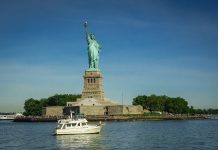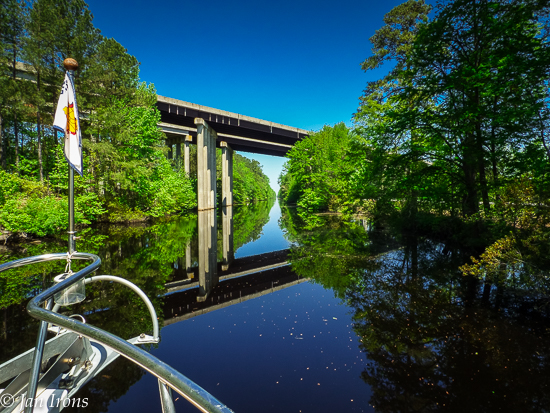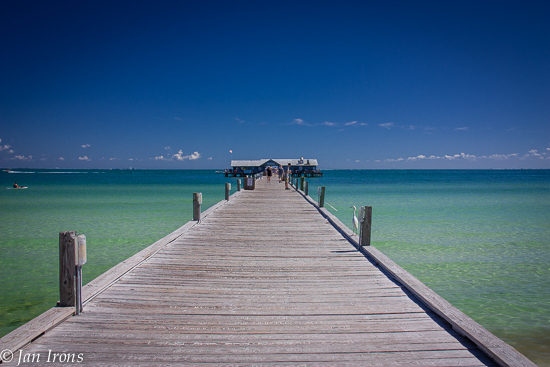Achutupu, Kuna Yala, Panama…. Every Kuna village has a story, all of them different and all fascinating. Some we like, some we don’t, but all are different. We’ve now visited six Kuna villages, Isla Pino was the smallest with under 300 residents, then Anachucana with 600 Kuna, then Caledonia with 1,200 and now Achutupu with 3,000. We had incorrectly assumed that the smallest villages would be the most interesting from a cultural perspective, but each village has it’s own personality. We sailed to Caledonia after our wonderful experiences in Anachucana and were immediately greeted by Castro, the “Secretary of Tourism” – very official with a badge and a list of printed rules – in English. Our initial impression was positive, Castro was friendly, he spoke a bit of English along with good Spanish. Upon visiting the village; however, we discovered that our welcome was decidedly cool, we were guided around very carefully and not allowed to interact with the villagers. We were ushered into what was obviously a restaurant set up for tourists and one family was invited to show us molas – and not high quality molas at that. I did buy one for $3.50, but overall we were very disappointed.

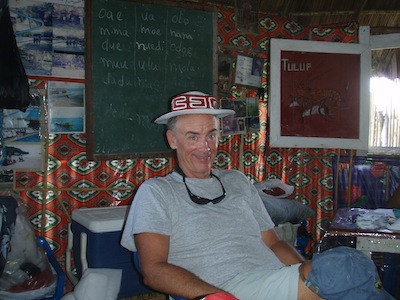
There were two highlights of Caledonia — first, the two boys that were fishing and stopped past daily – sometimes twice a day to practice their English … turns out the older boy, 13, goes to boarding school in Ustupu, a much larger island and he is learning English. Daily he wanted to learn new words … Ingles for “comer” – to eat, ingles for buscar – to look for, on & on. His curiosity was boundless and I wished I had a kids book in English to give him. We took his photo with his brother & went into town the day before we left … Castro acknowledged he knew the boy and wanted me to give him the photo so he could take it to the boy. I persisted and at last Castro had his assistant, Baptista, lead me to the young man’s house. He was very shy greeting us at the fenced opening to his family’s compound of huts and smiled when I gave him the photo but was embarrassed and quickly disappeared into the compound.
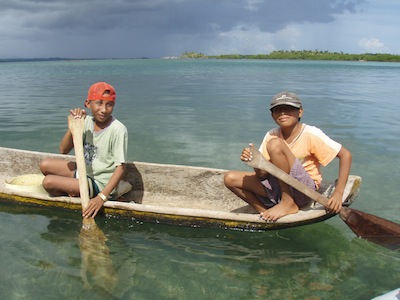
The second highlight in Caledonia was a fisherman who stopped past holding his fishing lure missing both hooks! Probably hard to catch a fish to feed your family on a handline with no hooks! J We didn’t have hooks to match but we had a similar lure which we gave to him along with some extra hooks that were slightly different. He spoke only Kuna, no Spanish or English, but seemed very grateful. The Kuna people benefit from the smallest things that we take for granted.
The flip side of Caledonia was the blaring radios, occasional television set and pool hall that seemed to us to detract from their Kuna culture much more than anything the four of us could do during a few hour visit. The molas they showed us were mostly appliqué and embroidery, not the beautiful art of the traditional mola – and some were even machine stitched. Apparently they’ve abandoned the traditional mola art in favor of cheap and quick machine embroidery to sell to the few tourists that visit. So we wonder, what’s more destructive to their culture – us? …. Or them???? In Caledonia’s case, it seems definitely them, and was sad.

In other places, Kuna Yala never fails to amaze us! Next we anchored at Achutupu – tupu in Kuna means “island”, so this was Dog Island in English – one of three Dog Islands in this 300 island group, I might add. Anchored at Achutupu, no one approached us to pay an anchoring fee or pay a fee to go ashore at their village. That did NOT mean we did not spend a lot of money! Our first anchorage, farthest away from the village, seemed perfect and when a cayuco with two men came paddling out, we assumed they would collect the usual fees … nope, they just wanted to tell us that where we were anchored, we’d be invaded by chitres (or noseeems) at sunset & sunrise because we were too close to the beach. Sure enough — YIKES! Needless to say, next morning, we took their advice & re-anchored closer to Achutupu, a village of 3,000 Kuna.

Here mola makers visit sailboats. The first day the visitors were a couple of wooden cayucos with kids – really CUTE kids, at that, with a few molas. And the kids speak Spanish as well as Kuna, so we can converse. The next day, immediately after coffee, David was working on our inverter fan, still plaguing us by refusing to shut off after the inverter is off … anyway, it was like a cloud of locusts descending! In the Kuna Congresso meeting last night, they must have decided that since we’d been anchored for two days and not been ashore, perhaps we weren’t coming ashore & they authorized all 3,000 people to sell us molas! At one point, we had two grandmothers, a five year old and her mother sitting in our cockpit looking through two huge feedsacks of molas. I happened to glance over at Kristiana (our buddy boat). Doug was entertaining one group of Kuna women on the foredeck, Rayene had another group in the cockpit looking at their molas and there were two more cayucos full of Kuna hovering around the boat waiting patiently for their turn. Rayene bought thirteen molas that day and I was lucky to only buy three!

It was very interesting that the elder grandmother in our cockpit wanted any plastic bottle we had … even the coke bottles in the trash. At the time, we thought it was strange, but it turned out the water pipe to this village is broken. So until they get it repaired which apparently is not a village priority, all the women paddle a mile or so downwind to reach a freshwater creek coming out of the mountains to gather fresh water. Their cayucos are loaded every morning by 7 AM with anything they can use to carry fresh water, commonly eight 5 gallon buckets of water that these women paddle back upwind. Note that it’s only women hauling water. Men haul coconuts, plantains and firewood, but never water.

The deluge of visitors didn’t stop until about 4 PM when an eerie silence descended on the anchorage. No cayucos sailing, no cayucos paddling past with children calling out “David” – they can say David’s name and so they call it as they paddle past, so cute, but a pain sometimes! Anyway, silence. Suddenly en masse, a flurry of sailing cayucos depart from the village headed to the airstrip behind where we’re anchored … always a new cultural experience sitting here in Achutupu!
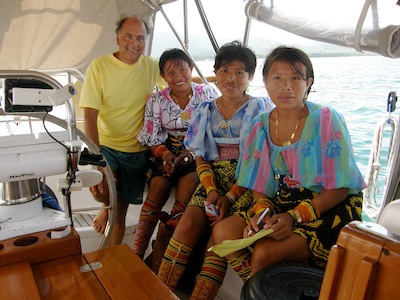
They beach the cayucos and begin hauling HUGE bags of something out of sight down the airstrip. Of course, the next day we investigate. Turns out the airstrip isn’t quite long enough for the Air Panama and Aeroperlas planes that land each morning from Panama City, bringing supplies and the rare tourist. So the Kuna are hauling sand, rocks and concrete to make the runway longer. They’ve started at the far end and there’s a gap between the original concrete runway and the new section about a half football field in length. We are proudly informed that they will have this project completed in 15 days. HUGE project … women, children everyone in the village appears to have been assigned to haul a certain number of 60# bags of sand down to the other end. First though, they have to dig the sand from the beach! There are two crude wheelbarrows, but I guess it’s easier for them to sling their headband bags over their heads & haul. These tiny people must be SO strong, it’s beyond comprehension! Amongst ourselves, we think the water repair would be more beneficial to the village than the runway extension, but they are definitely industrious and hard working!

After the sand was hauled, the cayucos raced back to the village – and guess who is anchored RIGHT in the middle of their racecourse! You guessed it! Winterlude and Kristiana! Sailing upwind in a crude wooden cayuco doesn’t seem likely, but shortly they’re all close reaching, FLYING past us in a 15 knot breeze, whitecaps piling into their boats requiring constant bailing to stay afloat. Sometimes we worry that they won’t be able to make a course correction in time to keep from t-boning Winterlude, but they’re expert sailors from a early age! We see kids as young as 8 expertly handling these craft, and toting around their younger siblings – sometimes as young as 3! The variety of sails was astounding, mostly pieced together sheets of many colors, a few had “real” sails, albeit ancient. One was green and red, seemed appropriate for our Christmas season! A few craft had mains and jibs, but most were rigged similar to an opti, and some had a sunfish style sail rig. They’re all smiling and laughing, calling out to one another as they race. They smile and call out the traditional Kuna greeting “Nuedi” — pronounced “new-aa(longA)-dee” – as they fly by us. When they reach the lee of their island village, they drop the sails – lifting the wooden spars and then the mast out of the hole carved directly into the bottom of the cayuco and paddle the rest of the way.
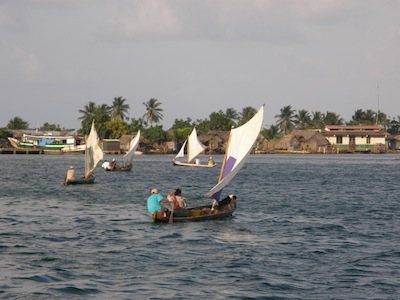
When we finally went ashore in Achutupu, we met a young man in an Indiana Pacers jersey! They asked us if we knew Reggie Miller! Small world! A dozen or so young boys were playing basketball on the town court and David joined in the fun to the delight of all. At first his airballs were unimpressive, but as he warmed to the action and began drilling jump shots, he was actually invited to join one of the teams the next day at 5 PM for their game! Afterwards, we bought fresh Kuna bread (breadsticks) – you know they’re fresh when you have to wait a few minutes for them to come out of the propane fueled oven. We stuff down a few to let them melt in our mouths while they’re still warm! Twenty breadsticks here cost $2.00 or 5 cents each, less than Anachucana!

That’s it from Kuna-land for this edition of Winterlude Update! Until the next installment be Happy & Safe!
David & Jan
Sv Winterlude, San Blas Islands, Panama

